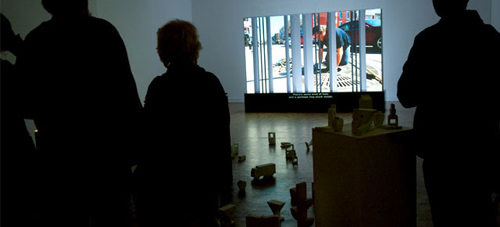Montréal, February 16, 2012 Société de transport de Montréal (STM) and the Rendez-vous du cinéma québécois (RVCQ) present the interactive installation BAR CODE, a National Film Board of Canada (NFB) and ARTE France co-production, at Berri-UQAM métro station, February 15 – 26, 2012. Montrealers, tourists and anyone visiting the city can come discover the stories behind everyday objects through 100 short films projected onto a giant code bar.
After a world premiere at the prestigious International Documentary Film Festival Amsterdam (IDFA) last November, the Montréal public will have the opportunity of discovering a unique work, a premiere in North America, that liberates it from the confines of the computer and moves it out into the centre of a public space. Dozens of everyday white objects scattered around a giant bar code: books, milk cartons, cell phones, keys, tennis racquets… Participants select an item and place it on an lit pedestal, scanning the bar code so it can tell the object’s story by showing a 60-second clip. BAR CODE is also a website, a mobile app and a television program. The installation was designed and developed by Hugues Bruyère of Departement.ca.
‘Our collaboration with the NFB and the Rendez-vous du cinéma québécois is giving the thousands of people who pass through Berri-UQAM station an opportunity to interact with an original installation and to share a body of film work with them,’’ explained STM board chairman Michel Labrecque. This initiative is part of our Métro Arts programming, offering free cultural activities to transit users and showcasing events happening in Montréal.’’
Québec Cinéma Executive Director Ségolène Roederer is pleased with preparations for this mega-project, as it enables film work to push back the limits of movie theatres and reach out to new audiences. ‘The BAR CODE installation is another expression of how dynamic modern film-making is, as it evolves and becomes available through other types of media, thanks to the talent and creativity of artists from here and elsewhere. Such an opening is also a wonderful way of celebrating the 30th edition of the RVCQ, one that features bold and imaginative programming focused on creativity,’ declared Ms. Roederer.
For Monique Simard, French Program Director for the NFB, ‘With its 100 short films by 30 filmmakers from Canada and Europe, this joint project transcends our view of everyday items and offers a new perspective on them. BAR CODE gathers various points of view, tones and styles, and having the installation inside the Montréal métro will no doubt add an amusing dimension to the experience for the thousands of passengers who pass by it. Our partnership with the STM and the RVCQ really makes it possible to bring an interactive work of art into a public gathering space and make it accessible on a whole other level.’
The interactive installation BAR CODE is accessible to all, for free, every day from 4 p.m. to 9 p.m. until February 26. Festival-goers taking part in the Nuit blanche All-Nighter February 25 – 26 will have all night to interact with the installation as the métro will stay open for the occasion. For more information about the installation, go to http://codebarre.tv/blogue
BAR CODE INSTALLATION

The Rendez-vous du cinéma québécois
Held until February 26 in six venues in the Quartier latin section of downtown’s Quartier des spectacles, the RVCQ are an absolute unique meeting place for cinéma’s professionals and viewing public, artists and artisans alike, who transform our cinema into an irresistibly singular body of work.’ For more information about programming, go to the festival’s web site at http://www.rvcq.com or to the Facebook page for Les Rendez-vous du cinéma québécois.
The STM promotes culture with its Métro Arts
The STM created the Métro Arts in order to make riding public transit a more pleasant experience and ensure the métro becomes a showcase for unique and original cultural expression. Developed in cooperation with the arts community, the STM’s Métro Arts promote new creative talent and quality presentations by making them available to as many people as possible while also promoting the use of public transit.
– 30 –